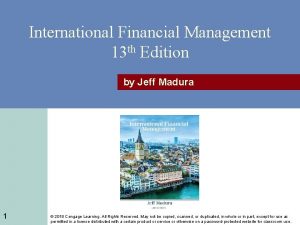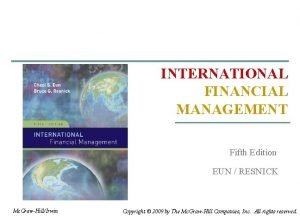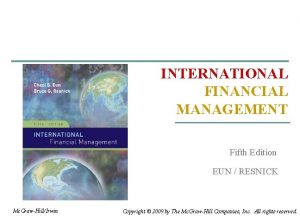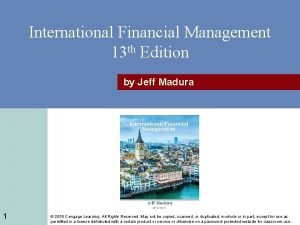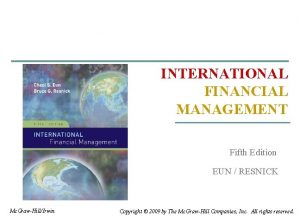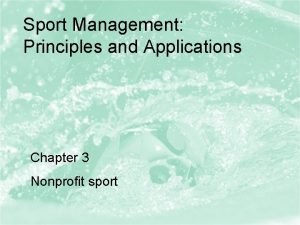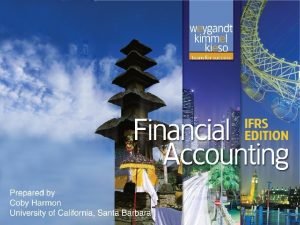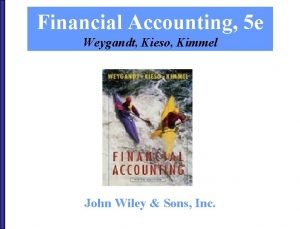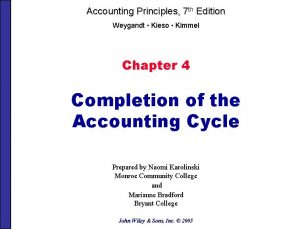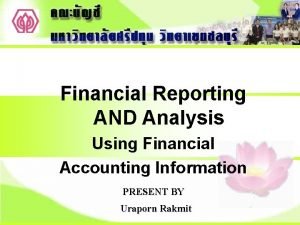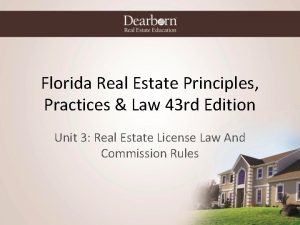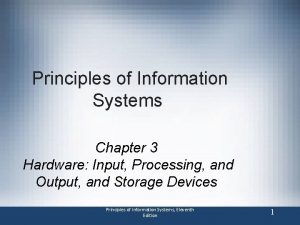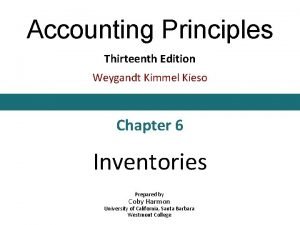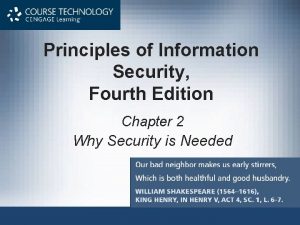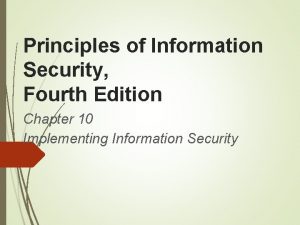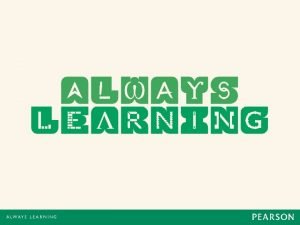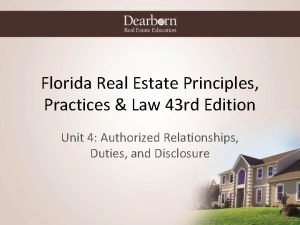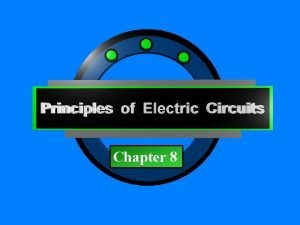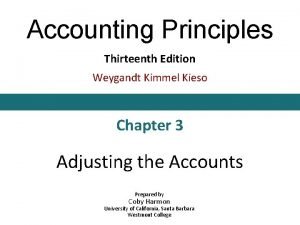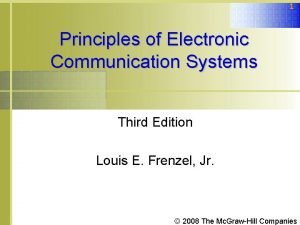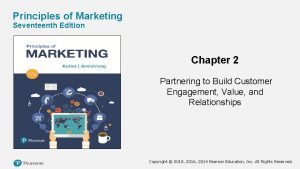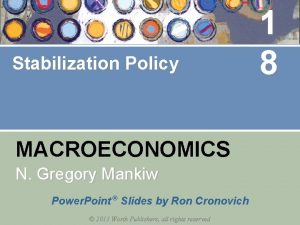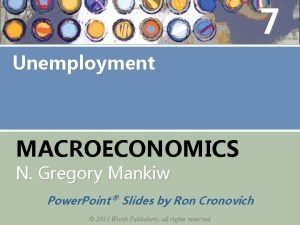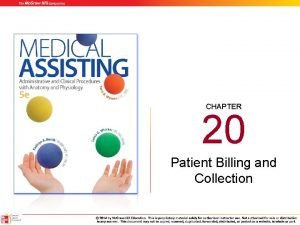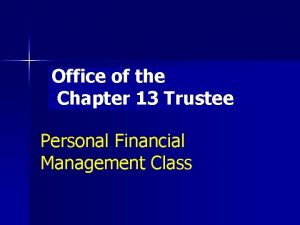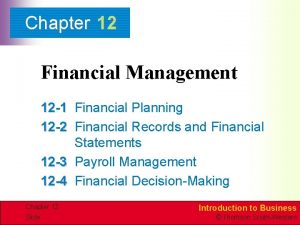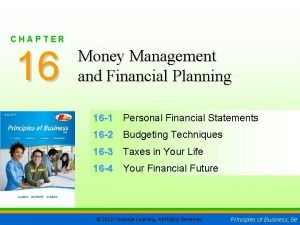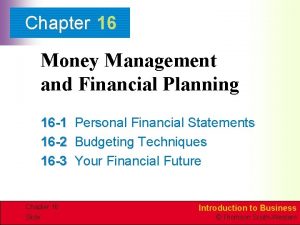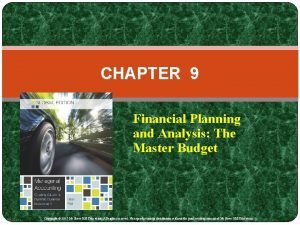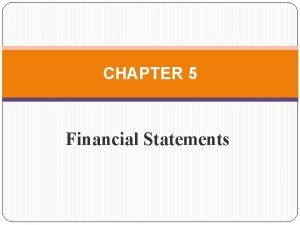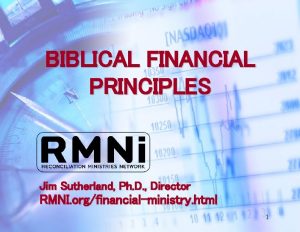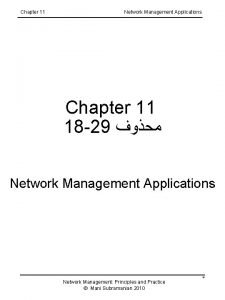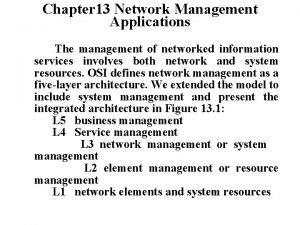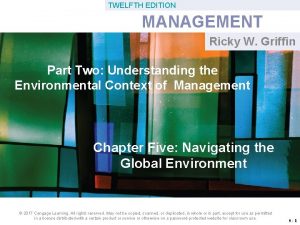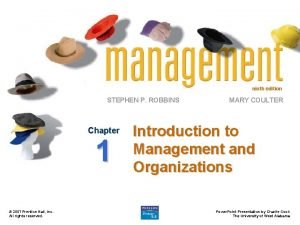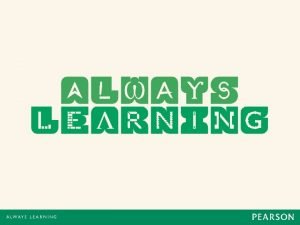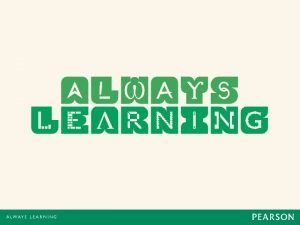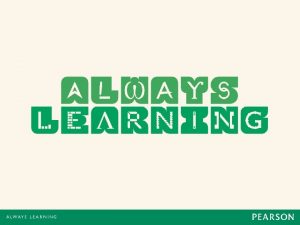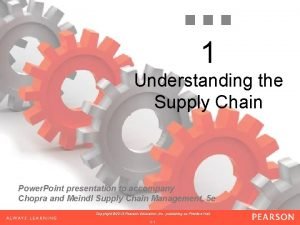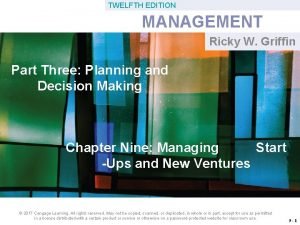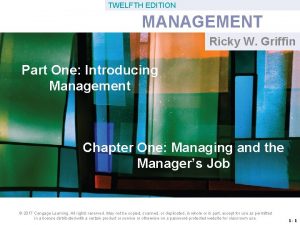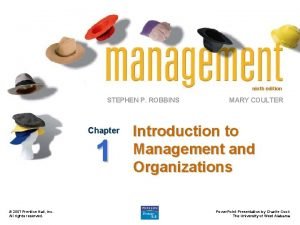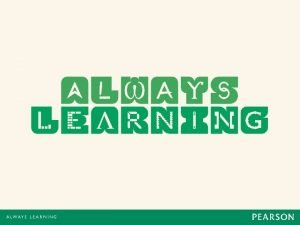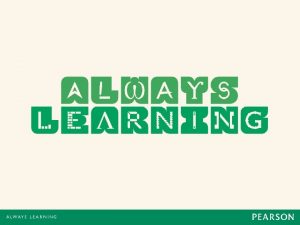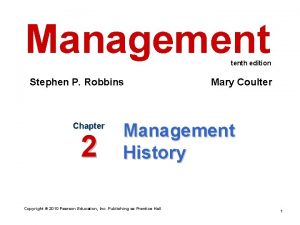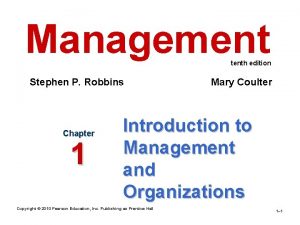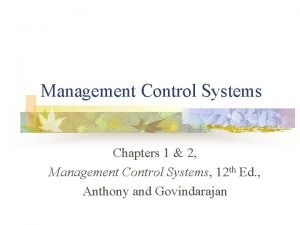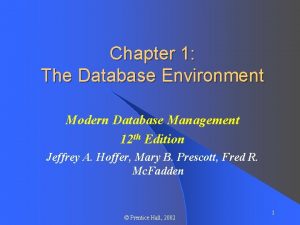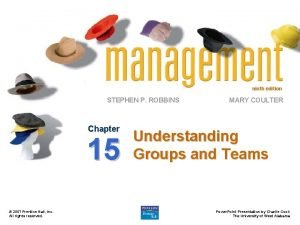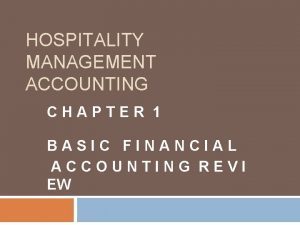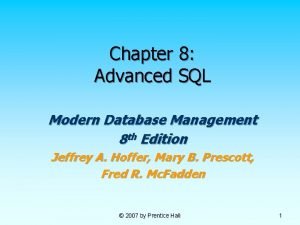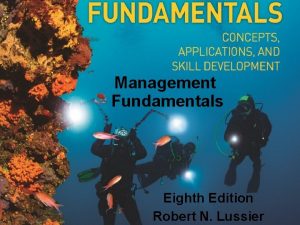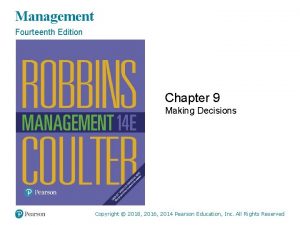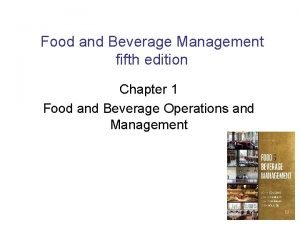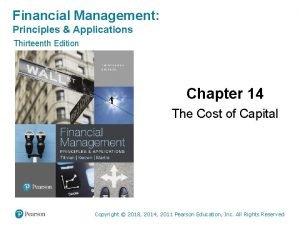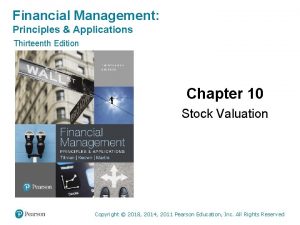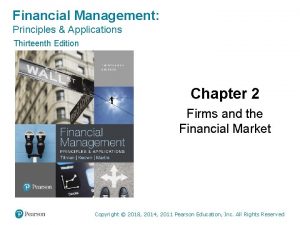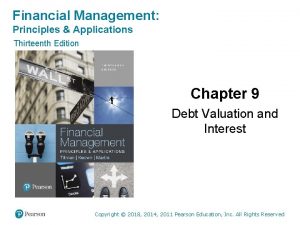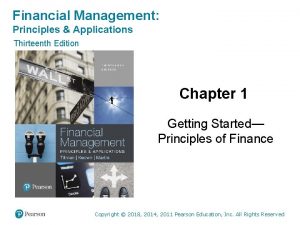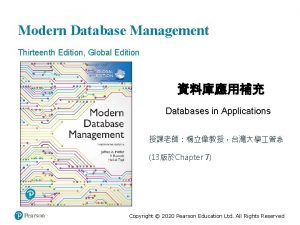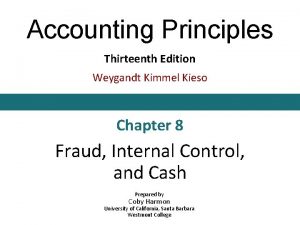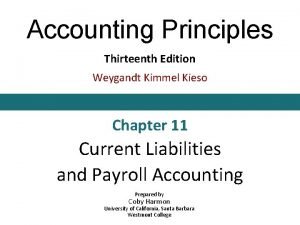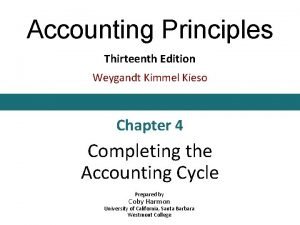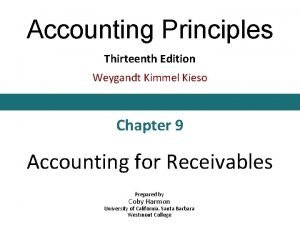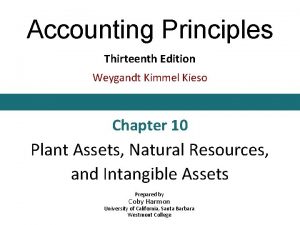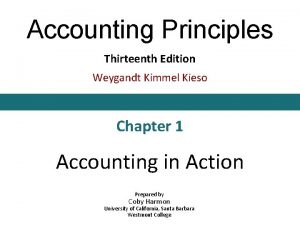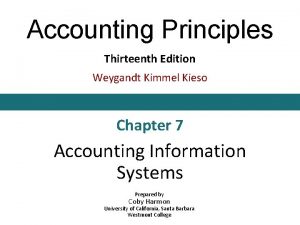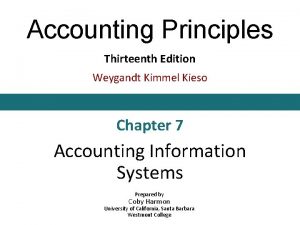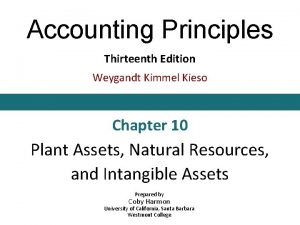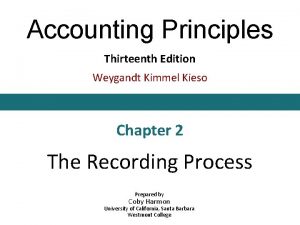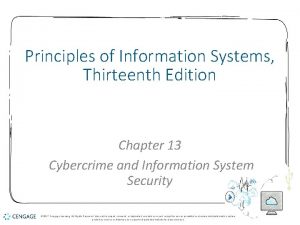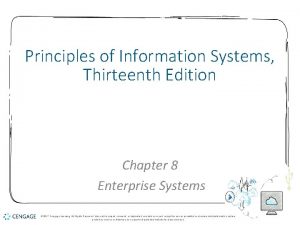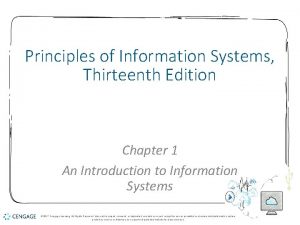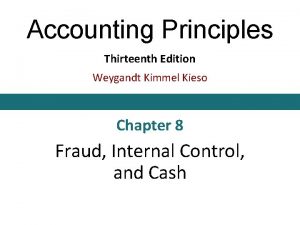Financial Management Principles Applications Thirteenth Edition Chapter 11





































































































- Slides: 101

Financial Management: Principles & Applications Thirteenth Edition Chapter 11 Investment Decision Criteria Copyright Education, © 2018, 2014, 2011 Pearson Inc. All Reserved Rights Reserved Copyright © 2018, 2014, 2011 Pearson Inc. Education, All Rights

Learning Objectives (1 of 2) 1. Understand how to identify the sources and types of profitable investment opportunities. 2. Evaluate investment opportunities using net present value and describe why net present value is the best measure to use. Copyright © 2018, 2014, 2011 Pearson Education, Inc. All Rights Reserved

Learning Objectives (2 of 2) 3. Use the profitability index, internal rate of return, and payback criteria to evaluate investment opportunities. 4. Understand current business practice with respect to the use of capital-budgeting criteria. Copyright © 2018, 2014, 2011 Pearson Education, Inc. All Rights Reserved

Principles Applied in This Chapter • • Principle 1: Money Has a Time Value. Principle 2: There is a Risk-Return Tradeoff. Principle 3: Cash Flows Are the Source of Value. Principle 5: Individuals Respond to Incentives. Copyright © 2018, 2014, 2011 Pearson Education, Inc. All Rights Reserved

11. 1 AN OVERVIEW OF CAPITAL BUDGETING Copyright © 2018, 2014, 2011 Pearson Education, Inc. All Rights Reserved

Disney’s Capital Budgeting Decision: Three Important Lessons (1 of 2) Disney’s decision to invest $17. 5 million to build Disneyland park in California in 1955 is an example of a major capital budgeting decision. How did this decision impact Disney? What important lessons can we learn from Disney theme park story? Copyright © 2018, 2014, 2011 Pearson Education, Inc. All Rights Reserved

Disney’s Capital Budgeting Decision: Three Important Lessons (2 of 2) 1. Capital budgeting decisions are critical in defining a company’s business 2. Very large investments frequently consist of smaller investment decisions that define a business strategy 3. Successful investment decisions lead to the development of managerial expertise and capabilities that influence the firm’s choice of future investments. Copyright © 2018, 2014, 2011 Pearson Education, Inc. All Rights Reserved

The Typical Capital—Budgeting Process • Phase I: The firm’s management identifies promising investment opportunities. • Phase II: The investment opportunity’s valuecreating potential-what some refer to as its value proposition-is thoroughly evaluated. Copyright © 2018, 2014, 2011 Pearson Education, Inc. All Rights Reserved

Types of Capital Investment Projects 1. Revenue enhancing Investments (such as introducing a new product line), 2. Cost-reducing investments (such as replacing old equipment with a more efficient equipment), and 3. Mandatory investments that are a result of government mandates (such as investments to meet safety and environmental regulations) Copyright © 2018, 2014, 2011 Pearson Education, Inc. All Rights Reserved

11. 2 NET PRESENT VALUE Copyright © 2018, 2014, 2011 Pearson Education, Inc. All Rights Reserved

Net Present Value • The net present value (NPV) is the difference between the present value of cash inflows and the cash outflows. NPV estimates the amount of wealth that the project creates. • Decision Criteria: Investment projects should be accepted if the NPV of the project is positive and should be rejected if the NPV is negative. Copyright © 2018, 2014, 2011 Pearson Education, Inc. All Rights Reserved

Calculating an Investment’s NPV (1 of 2) Cost of making the investment = Initial cash flow (this is typically a cash outflow, taking on a negative value) Present value of the investment’s cash inflows = Present value of the project’s future cash inflows Copyright © 2018, 2014, 2011 Pearson Education, Inc. All Rights Reserved

Calculating an Investment’s NPV (2 of 2) NPV reflects the first three principles: The project’s cash flows are used to measure the benefits the project provides (Principle 3, cash flows are the source of value), cash flows are discounted back to the present (Principle 1, money has time value), and the discount rate used to discount the cash flows back to the present reflects the risk in the future cash flows (Principle 2, There is a risk-return tradeoff) Copyright © 2018, 2014, 2011 Pearson Education, Inc. All Rights Reserved

CHECKPOINT 11. 1: CHECK YOURSELF Calculating the NPV Copyright © 2018, 2014, 2011 Pearson Education, Inc. All Rights Reserved

The Problem Saber Electronics provides specialty manufacturing services to defense contractors located in the Seattle, Washington area. The initial outlay is $3 million and, management estimates that the firm might generate cash flows for years one through five equal to $500, 000; $750, 000; $1, 500, 000; $2, 000; and $2, 000. Saber uses a 20% discount rate for projects of this type. Is this a good investment opportunity? Copyright © 2018, 2014, 2011 Pearson Education, Inc. All Rights Reserved

Step 1: Picture the Problem k = 20% Years 0 1 2 3 −$3 M +$0. 5 M +$0. 75 M +$1. 5 M 4 5 $2 M Cash flows (in $ millions) Net Present Value = ? Copyright © 2018, 2014, 2011 Pearson Education, Inc. All Rights Reserved

Step 2: Decide on a Solution Strategy • We need to analyze if this is a good investment opportunity. We can do that by computing the Net Present Value (NPV), which requires computing the present value of all cash flows. • We can compute the NPV by using a mathematical formula, a financial calculator or a spreadsheet. Copyright © 2018, 2014, 2011 Pearson Education, Inc. All Rights Reserved

Step 3: Solve (1 of 3) Using a Mathematical Formula Cost of making the investment = Initial cash flow (this is typically a cash outflow, taking on a negative value) Present value of the investment’s cash inflows = Present value of the project’s future cash inflows Copyright © 2018, 2014, 2011 Pearson Education, Inc. All Rights Reserved

Step 3: Solve (2 of 3) • NPV = −$3 m + $. 5 m/(1. 2) + $. 75 m/(1. 2)2 + $1. 5 m/(1. 2)3 + $2 m/(1. 2)4 • NPV = −$3, 000 + $416, 666. 67 + $520, 833. 30 + $868, 055. 60 + $964, 506 + $803, 755. 10 • NPV = $573, 817 Copyright © 2018, 2014, 2011 Pearson Education, Inc. All Rights Reserved

Step 3: Solve (3 of 3) Using an Excel Spreadsheet NPV = NPV (discount rate, CF 1 -5 ) + CF 0 = NPV(. 20, 500000, 750000, 1500000, 2000000) − 3000000 = $573, 817 Copyright © 2018, 2014, 2011 Pearson Education, Inc. All Rights Reserved

Step 4: Analyze • The project requires an initial investment of $3, 000 and generates futures cash flows that have a present value of $3, 573, 817. Consequently, the project cash flows are $573, 817 more than the required investment. • Since the NPV is positive, the project is an acceptable project. Copyright © 2018, 2014, 2011 Pearson Education, Inc. All Rights Reserved

Independent Versus Mutually Exclusive Investment Projects • An independent investment project is one that stands alone and can be undertaken without influencing the acceptance or rejection of any other project. • Accepting a mutually exclusive project prevents another project from being accepted. Copyright © 2018, 2014, 2011 Pearson Education, Inc. All Rights Reserved

Evaluating an Independent Investment Opportunity It requires two steps to evaluate: 1. Calculate NPV; 2. Accept the project if NPV is positive and reject if it is negative. Copyright © 2018, 2014, 2011 Pearson Education, Inc. All Rights Reserved

Evaluating Mutually Exclusive Investment Opportunities Following are two situations where firm is faced with mutually exclusive projects: 1. Substitutes – When a firm is analyzing two or more alternative investments, and each performs the same function. 2. Firm Constraints – Firm faces constraints such as limited managerial time or limited financial capital that limit its ability to invest in every positive NPV project. Copyright © 2018, 2014, 2011 Pearson Education, Inc. All Rights Reserved

Choosing Between Mutually Exclusive Investments (1 of 2) 1. If mutually exclusive investments have equal lives, we will calculate the NPVs and choose the one with the higher NPV. 2. If mutually exclusive investments do not have equal lives, we must calculate the Equivalent Annual Cost (EAC). The EAC technique provides an estimate of the annual cost of owning and operating the investment over its lifetime. We will then select the one that has a lower EAC. Copyright © 2018, 2014, 2011 Pearson Education, Inc. All Rights Reserved

Choosing Between Mutually Exclusive Investments (2 of 2) Computation of EAC Copyright © 2018, 2014, 2011 Pearson Education, Inc. All Rights Reserved

CHECKPOINT 11. 2: CHECK YOURSELF Calculating the Equivalent Annual Cost Copyright © 2018, 2014, 2011 Pearson Education, Inc. All Rights Reserved

Copyright © 2018, 2014, 2011 Pearson Education, Inc. All Rights Reserved

Copyright © 2018, 2014, 2011 Pearson Education, Inc. All Rights Reserved

Copyright © 2018, 2014, 2011 Pearson Education, Inc. All Rights Reserved

The Problem What is the EAC for a machine that costs $50, 000, requires payment of $6, 000 per year for maintenance and operation expense, and lasts for 6 years? You may assume that the discount rate is 9% and there will be no salvage value associated with the machine. In addition, you intend to replace this machine at the end of its life with an identical machine with identical costs. Copyright © 2018, 2014, 2011 Pearson Education, Inc. All Rights Reserved

Step 1: Picture the Problem k = 9% Years Cash flows (in $, thousands) EAC = ? 0 −$50 1 2 3 4 5 6 −$6 −$6 −$6 Copyright © 2018, 2014, 2011 Pearson Education, Inc. All Rights Reserved

Step 2: Decide on a Solution Strategy Here we need to calculate the EAC, which will tell us the annual cost for a machine that lasts 6 years. EAC can be computed using a mathematical formula or financial calculator. Copyright © 2018, 2014, 2011 Pearson Education, Inc. All Rights Reserved

Step 3: Solve (1 of 5) Using a Mathematical Formula It requires 2 steps: 1. Computation of NPV 2. Computation of EAC Copyright © 2018, 2014, 2011 Pearson Education, Inc. All Rights Reserved

Step 3: Solve (2 of 5) Cost of making the investment = Initial cash flow (this is typically a cash outflow, taking on a negative value) Present value of the investment’s cash inflows = Present value of the project’s future cash inflows NPV = −$50, 000 + PV of $6, 000 each year = −$50, 000 + −$6, 000 (PV of Annuity Factor) = −$50, 000 + −$6, 000 {[1−(1/(1. 09)6] ÷ (. 09)} = −$50, 000 + −$6, 000 {4. 4859) = −$76, 915 Copyright © 2018, 2014, 2011 Pearson Education, Inc. All Rights Reserved

Step 3: Solve (3 of 5) EAC = NPV ÷ Annuity Factor = −$76, 915 ÷ 4. 4859 = −$17, 145. 95 Copyright © 2018, 2014, 2011 Pearson Education, Inc. All Rights Reserved

Step 3: Solve (4 of 5) Using a Financial Calculator • Data and Key Input Display ↓CF; − 50000; ENTER CFO = − 50000 ; − 6000; ENTER CO 1 = − 6000 ; 6; ENTER FO 1 = 6. 00 NPV; 8; ENTER i=8 CPT NPV = − 77, 372 Copyright © 2018, 2014, 2011 Pearson Education, Inc. All Rights Reserved

Step 3: Solve (5 of 5) Enter – N=6 – 1/y = 9 – PV = − 76915 – FV = 0 – PMT = − 17, 145. 86 Thus EAC = $− 17, 145. 86 Copyright © 2018, 2014, 2011 Pearson Education, Inc. All Rights Reserved

Step 4: Analyze EAC indicates the annual cost that is adjusted for time value of money. Here EAC is equal to $17, 145. 86. Copyright © 2018, 2014, 2011 Pearson Education, Inc. All Rights Reserved

11. 3 OTHER INVESTMENT CRITERIA Copyright © 2018, 2014, 2011 Pearson Education, Inc. All Rights Reserved

Profitability Index (1 of 2) The profitability index (PI) is a cost-benefit ratio equal to the present value of an investment’s future cash flows divided by its initial cost. Copyright © 2018, 2014, 2011 Pearson Education, Inc. All Rights Reserved

Profitability Index (2 of 2) Decision Criteria: – If PI is greater than one, the NPV will be positive and the investment should be accepted – When PI is less than one, which indicates a bad investment, NPV will be negative and the project should be rejected. Copyright © 2018, 2014, 2011 Pearson Education, Inc. All Rights Reserved

CHECKPOINT 11. 3: CHECK YOURSELF Calculating the Profitability Index Copyright © 2018, 2014, 2011 Pearson Education, Inc. All Rights Reserved

The Problem (1 of 2) PNG Pharmaceuticals is considering an investment in a new automated materials handling system that is expected to reduce its drug manufacturing costs by eliminating much of the waste currently involved in its specialty drug division. The new system will require an initial investment of $50, 000 and is expected to provide cash savings over the next sixyear period as shown on next slide. Copyright © 2018, 2014, 2011 Pearson Education, Inc. All Rights Reserved

The Problem (2 of 2) Year Expected Cash Flow 0 −$50, 000 1 $15, 000 2 $8, 000 3 $10, 000 4 $12, 000 5 $14, 000 6 $16, 000 Copyright © 2018, 2014, 2011 Pearson Education, Inc. All Rights Reserved

Step 1: Picture the Problem k = 10% Years Cash flows 0 1 −$50 +$15 2 +$8 3 4 5 6 +$10 +$12 +$14 +$16 (in $, thousands) PI = ? Copyright © 2018, 2014, 2011 Pearson Education, Inc. All Rights Reserved

Step 2: Decide on a Solution Strategy The PI for a project is equal to the present value of the project’s expected cash flows for years 1 -6 divided by the initial outlay. PI = PV of expected cash flows ÷ −Initial outlay Copyright © 2018, 2014, 2011 Pearson Education, Inc. All Rights Reserved

Step 3: Solve (1 of 3) We can proceed in two steps: 1. Compute PV of expected cash flows by discounting the cash flows from Year 1 to Year 6 at 10%. PVt = CFt ÷ (1. 09)t 2. Compute PI Copyright © 2018, 2014, 2011 Pearson Education, Inc. All Rights Reserved

Step 3: Solve (2 of 3) Step 1: Computing PV of Cash Inflows Year Expected Cash flow Present Value at 10% discount rate 1 $15, 000 $13, 636. 36 2 $8, 000 $6, 611. 57 3 $10, 000 $7, 513. 14 4 $12, 000 $8, 196. 16 5 $14, 000 $8, 692. 90 6 $16, 000 $9, 031. 58 PV of Expected Cash flows, Years 1 -6 Blank $53, 681. 72 Copyright © 2018, 2014, 2011 Pearson Education, Inc. All Rights Reserved

Step 3: Solve (3 of 3) Step 2: Compute the PI PI = PV of expected CF 1 -6 ÷ Initial Outlay = $53, 681. 72 ÷ $50, 000 = 1. 0733 Copyright © 2018, 2014, 2011 Pearson Education, Inc. All Rights Reserved

Step 4: Analyze • PNG Pharmaceuticals requires an initial investment of $50, 000 and provides future cash flows that have a present value of $53, 681. 72. Thus, PI is equal to 1. 0733. • It is an acceptable project since PI is greater than one. Copyright © 2018, 2014, 2011 Pearson Education, Inc. All Rights Reserved

Internal Rate of Return (1 of 3) The internal rate of return (IRR) of an investment is analogous to the yield to maturity (YTM) on a bond as defined in Chapter 9. Specifically, the IRR is the discount rate that results in a zero NPV for the project. Copyright © 2018, 2014, 2011 Pearson Education, Inc. All Rights Reserved

Internal Rate of Return (2 of 3) Copyright © 2018, 2014, 2011 Pearson Education, Inc. All Rights Reserved

Internal Rate of Return (3 of 3) Decision Criteria: Accept the project if the IRR is greater than the required rate of return or discount rate used to calculate the net present value of the project, and reject it otherwise. Copyright © 2018, 2014, 2011 Pearson Education, Inc. All Rights Reserved

CHECKPOINT 11. 4: CHECK YOURSELF Calculating the IRR Copyright © 2018, 2014, 2011 Pearson Education, Inc. All Rights Reserved

The Problem (1 of 2) Knowledge Associates is a small consulting firm in Portland, Oregon, and they are considering the purchase of a new copying center for the office that can copy, fax, and scan documents. The new machine costs $10, 010 to purchase and is expected to provide cash flow savings over the next four years of $1, 000; $3, 000; $6, 000; and $7, 000. Copyright © 2018, 2014, 2011 Pearson Education, Inc. All Rights Reserved

The Problem (2 of 2) The employee in charge of performing financial analysis of the proposed investment has decided to use the IRR as her primary criterion for making a recommendation to the managing partner of the firm. If the discount rate the firm uses to value the cash flows from office equipment purchases is 15%, is this a good investment for the firm? Copyright © 2018, 2014, 2011 Pearson Education, Inc. All Rights Reserved

Step 1: Picture the Problem Years Cash flows 0 1 2 3 4 −$10, 010 +$1, 000 +$3, 000 +$6, 000 +$7, 000 IRR = ? Copyright © 2018, 2014, 2011 Pearson Education, Inc. All Rights Reserved

Step 2: Decide on a Solution Strategy • Here we have to calculate the project’s IRR is equal to the discount rate that makes the present value of the future cash flows (in years 14) equal to the initial cash outflow of $10, 010. • We can compute the IRR using trial & error, financial calculator or an excel spreadsheet. Copyright © 2018, 2014, 2011 Pearson Education, Inc. All Rights Reserved

Step 3: Solve (1 of 4) Using a Mathematical Formula – This will require finding the rate at which NPV is equal to zero. – We compute the NPV at different rates to determine the range of IRR. Copyright © 2018, 2014, 2011 Pearson Education, Inc. All Rights Reserved

Step 3: Solve (2 of 4) This table suggests that IRR is between 15% and 20%. Discount Rate Computed NPV 0% $6, 990 5% $4, 605 10% $2, 667 15% $1, 075 20% −$245 Copyright © 2018, 2014, 2011 Pearson Education, Inc. All Rights Reserved

Step 3: Solve (3 of 4) Data and Key Input Display CF; − 100000; ENTER CFO = − 100000 ↓; 1000; ENTER CO 1 = 1000 ↓; 1; ENTER FO 1 = 1. 00 ↓; 3000; ENTER C 02 = 3000 ↓; 1; ENTER FO 2 = 1. 00 ↓; 6000; ENTER C 03 = 6000 ↓; 1; ENTER FO 3 = 1. 00 ↓; 7000; ENTER CO 4 = 7000 ↓; 1; ENTER FO 4 = 1. 00 IRR; CPT IRR = 19% Copyright © 2018, 2014, 2011 Pearson Education, Inc. All Rights Reserved

Step 3: Solve (4 of 4) Using an Excel Spread sheet Rows in Excel Column A in Excel Column B in Excel 1 Year Annual Cash flow 2 0 −$10, 010 3 1 $1, 000 4 2 $3, 000 5 3 $6, 000 6 4 $7, 000 7 Blank 8 IRR 19% Enter: IRR(b 2: b 6) Copyright © 2018, 2014, 2011 Pearson Education, Inc. All Rights Reserved

Step 4: Analyze The new copying center requires an initial investment of $10, 010 and provides future cash flows that offer a return of 19%. Since the firm has decided 15% as the minimum acceptable return, this is a good investment for the firm. Copyright © 2018, 2014, 2011 Pearson Education, Inc. All Rights Reserved

Complications with IRR: Multiple Rates of Return When the first cash flow is negative and the subsequent cash flows are positive, there is one unique IRR. However, there can be multiple values for the IRR when at least one of the later cash flow is negative. Checkpoint 11. 5 demonstrates a project that has two IRRs. Copyright © 2018, 2014, 2011 Pearson Education, Inc. All Rights Reserved

CHECKPOINT 11. 5: CHECK YOURSELF The Problem of Multiple IRRs For Projects Copyright © 2018, 2014, 2011 Pearson Education, Inc. All Rights Reserved

Copyright © 2018, 2014, 2011 Pearson Education, Inc. All Rights Reserved

Using the IRR with Mutually Exclusive Investments Figure 11. 1 shows that if we use NPV, project AA+ is better while if we use IRR, project BBR is better. How to select under such circumstances? – Use NPV as it will give the correct ranking for the projects. Copyright © 2018, 2014, 2011 Pearson Education, Inc. All Rights Reserved

Figure 11. 1 Ranking Mutually Exclusive Investments: NPV vs. IRR (1 of 3) (Panel A) Expected Cash Flows Year AA+ BBR 0 $(500, 000) 1 100, 000 400, 000 2 200, 000 3 300, 000 200, 000 4 400, 000 200, 000 5 500, 000 100, 000 NPV $412, 730 $370, 241 IRR 38% 52% • Both alternatives have positive NPVs and IRRs that exceed Apex’s 15% required rate of return. • However, the projects are ranked differently using NPV or IRR: AA+ has the higher NPV, while BBR has a higher IRR. • The ranking difference is due to the effect of discounting and the difference in the patterns of the cash flows for the two projects. • AA+’s cash flows increase over time, while BBR’s decrease. • Higher discount rates have a disproportionate effect on present values, as we see in Panel B. Copyright © 2018, 2014, 2011 Pearson Education, Inc. All Rights Reserved

Figure 11. 1 Ranking Mutually Exclusive Investments: NPV vs. IRR (2 of 3) (Panel B) NPV Profiles Discount Rate AA+ BBR 0% $1, 000 $700, 000 5% $ 756, 639 $568, 722 10% $ 565, 259 $460, 528 15% $ 412, 730 $370, 241 20% $ 289, 673 $294, 046 25% $ 189, 280 $229, 088 30% $ 106, 532 $173, 199 35% $ 37, 680 $124, 709 40% $ (20, 111) $ 82, 317 45% $ (69, 011) $ 44, 998 50% $ (110, 700) $ 11, 934 55% $ (146, 489) $ (17, 531) 60% $ (177, 414) $ (43, 930) 65% $ (204, 298) $ (67, 701) Copyright © 2018, 2014, 2011 Pearson Education, Inc. All Rights Reserved

Figure 11. 1 Ranking Mutually Exclusive Investments: NPV vs. IRR (3 of 3) (Panel C) Estimating the Break-Even Discount Rate Blank Cash Flows Blank AA+ BBR 0 $(500, 000) 1 100, 000 400, 000 $ 300, 000 2 200, 000 300, 000 $ 100, 000 3 300, 000 200, 000 $(100, 000) 4 400, 000 200, 000 $(200, 000) 5 500, 000 100, 000 $(400, 000) Year Differential Cash Flows BBR − AA+ $ 0 • Using a 19. 5% discount rate, the two projects have exactly the same NPV. • For discount rates lower than this break-even 19. 5% rate, AA+ has the higher NPV, whereas for higher discount rates BBR has the higher NPV. • Trust NPV. Given the discount rate appropriate for valuing project cash flows, NPV gives the correct ranking of projects! IRR of the Differential Cash Flows = 19. 5% Copyright © 2018, 2014, 2011 Pearson Education, Inc. All Rights Reserved

Modified Internal Rate of Return (1 of 2) Modified Internal Rate of Return (MIRR) eliminates the problem of multiple IRRs. MIRR rearranges the project cash flows such that there is only one change in the sign of the cash flows over the life of the project. There are two steps to computing MIRR. Copyright © 2018, 2014, 2011 Pearson Education, Inc. All Rights Reserved

Modified Internal Rate of Return (2 of 2) Step 1: Modify the project’s cash flow stream by discounting the negative future cash flows back to the present using the discount rate. The present value of these future negative cash flows is then added to the initial outlay to form a modified project cash flow stream Step 2: MIRR = IRR (modified cash flow stream). Copyright © 2018, 2014, 2011 Pearson Education, Inc. All Rights Reserved

CHECKPOINT 11. 6: CHECK YOURSELF Calculating the MIRR Analyze the MIRR for the preceding problem where the required rate of return used to discount the cash flows is 8%. What is the MIRR? Copyright © 2018, 2014, 2011 Pearson Education, Inc. All Rights Reserved

Step 1: Picture the Problem i = 8% Years Cash flows 0 −$235, 000 First Sign change 1 $540, 500 2 −$310, 200 Second Sign change Copyright © 2018, 2014, 2011 Pearson Education, Inc. All Rights Reserved

Step 2: Decide on a Solution Strategy • If we use IRR, we will get multiple IRRs as there are two sign changes in cash flow stream. • We can use MIRR by doing the following: – First, discount the year 2 negative cash flows back to year 0 using the 8% discount rate. – Second, calculate the MIRR of the resulting cash flows for years 0 and 1. Copyright © 2018, 2014, 2011 Pearson Education, Inc. All Rights Reserved

Step 3: Solve (1 of 2) Discount the year 2 negative cash flows to year 0. Years 0 1 2 Cash flows −$235, 000 $540, 50 −$310, 200 −$265, 947 −$500, 947 Copyright © 2018, 2014, 2011 Pearson Education, Inc. All Rights Reserved

Step 3: Solve (2 of 2) The modified cash flow stream is as follows: Years Cash flows 0 1 2 −$500, 947 $540, 500 −$0 • Calculating the IRR for the above modified cash flows produces MIRR equal to 7. 9% Copyright © 2018, 2014, 2011 Pearson Education, Inc. All Rights Reserved

Step 4: Analyze We were able to compute IRR by eliminating the second sign change and thus modifying the cash flows. MIRR is not the same as IRR as modified cash flows are discounted based on the discount rate used to calculate NPV (which is not the same as IRR). Copyright © 2018, 2014, 2011 Pearson Education, Inc. All Rights Reserved

Payback Period (1 of 2) • The Payback period for an investment opportunity is the number of years needed to recover the initial cash outlay required to make the investment. • Decision Criteria: Accept the project if the payback period is less than a prespecified maximum number of years. Copyright © 2018, 2014, 2011 Pearson Education, Inc. All Rights Reserved

Payback Period (2 of 2) Limitations 1. It ignores the time value of money 2. It ignores cash flows that are generated by the project beyond the end of the payback period. 3. It utilizes an arbitrary cutoff criterion. Copyright © 2018, 2014, 2011 Pearson Education, Inc. All Rights Reserved

Table 11. 1 Limitations of the Payback Period Criterion Project Long Blank Initial cash outlay Project Short Annual Cash Flow Cumulative Cash Flow $(100, 000) Year 1 70, 000 (30, 000) 50, 000 (50, 000) Year 2 30, 000 0 50, 000 0 Year 3 30, 000 0 0 Year 4 25, 000 55, 000 0 0 Year 5 10, 000 65, 000 0 0 The payback period equals two years for both projects because it takes two years to recover the cost of the initial outlay from the cash inflows. However, Project Long looks a lot better because it continues to provide cash inflows after the payback year. Copyright © 2018, 2014, 2011 Pearson Education, Inc. All Rights Reserved

Discounted Payback Period • Discounted payback period approach is similar except that it uses discounted cash flows to calculate the payback period. • Decision Criteria: Accept the project if its discounted payback period is less than the prespecified number of years. Copyright © 2018, 2014, 2011 Pearson Education, Inc. All Rights Reserved

Table 11. 2 Discounted Payback Period Example (Discount Rate = 17 percent) (1 of 2) Project Long Blank Initial cash outlay Annual Cash Flow Cumulative Cash Flow Discounted Cash Flow Cumulative Discounted Cash Flow $(100, 000) Year 1 70, 000 Year 2 30, 000 Year 3 (30, 000) 59, 829 (40, 171) 0 21, 915 (18, 256) 30, 000 18, 731 476 Year 4 25, 000 55, 000 13, 341 13, 817 Year 5 10, 000 65, 000 4, 561 18, 378 The discounted payback period equals 2. 97 years for Project Long. Three years of discounted cash flows sum to a positive $476. However, since we need to sum to 0, we do not need a full three years of discounted cash flows (we need $18, 256/$18, 731 =. 97 of Year 3’s cash inflow). Copyright © 2018, 2014, 2011 Pearson Education, Inc. All Rights Reserved

Table 11. 2 Discounted Payback Period Example (Discount Rate = 17 percent) (2 of 2) Project Short Blank Initial cash outlay Annual Cash Flow Cumulative Cash Flow Discounted Cash Flow Cumulative Discounted Cash Flow $(100, 000) Year 1 50, 000 Year 2 50, 000 (50, 000) 0 42, 735 (57, 265) 36, 526 (20, 739) Year 3 − − − (20, 739) Year 4 − − − (20, 739) Year 5 − − − (20, 739) Discounted payback is never achieved for Project Short. The discounted cash flows never cumulate to equal zero. Copyright © 2018, 2014, 2011 Pearson Education, Inc. All Rights Reserved

11. 4 A GLANCE AT ACTUAL CAPITAL BUDGETING PRACTICES Copyright © 2018, 2014, 2011 Pearson Education, Inc. All Rights Reserved

A Glance at Actual Capital Budgeting Practices • Figure 11. 2 provides the results of a survey of the CFOs of large US firms, showing the popularity of various tools. • The results show that NPV and IRR methods are by far the most widely used methods, although more than half the firms surveyed did use the Payback method. Copyright © 2018, 2014, 2011 Pearson Education, Inc. All Rights Reserved

Figure 11. 2 Survey of the Popularity of Capital—Budgeting Methods Copyright © 2018, 2014, 2011 Pearson Education, Inc. All Rights Reserved

Table 11. 3 Basic Capital—Budgeting Techniques (1 of 4) Investment Criterion Definition Decision Rule Advantages Disadvantages Net present value (NPV) The present value of expected cash inflows minus the present value of expected cash outflows. Accept investments that have a positive NPV. Is theoretically correct in that it measures directly the increase in value that the project is expected to produce. Measures the increase in shareholder wealth expected from undertaking the project being analyzed. Is somewhat complicated to compute (requires an understanding of the time value of money). Is not familiar to managers without formal business education. Equivalent annual cost (EAC) or equivalent annual annuity (EAA) The annual cost that is equivalent in present value to the initial cost and annual cash flows of an investment. Select the investment alternative that has the lowest annual cost. Provides a tool that can be used to account for different initial costs of purchase, different annual costs of operation, and different productive lives. Should be used only where the investments being compared are expected to be used indefinitely. For single-use investments, the NPV is appropriate. Copyright © 2018, 2014, 2011 Pearson Education, Inc. All Rights Reserved

Table 11. 3 Basic Capital—Budgeting Techniques (2 of 4) Investment Criterion Definition Decision Rule Advantages Disadvantages Profitability index (PI) The present value of expected future cash flows divided by the initial cash investment. When the PI is greater than 1, the NPV will be positive, so the project should be accepted. When PI is less than 1, the NPV will be negative, which indicates a bad investment, and the project should be rejected. Is theoretically correct in that it measures directly the increase in value that the project is expected to produce. Is useful when rank ordering positive. NPV projects where capital is being rationed. Is not as familiar to managers as the NPV. Does not add any additional information to the NPV. Internal rate of return (IRR) The discount rate that makes the NPV equal to zero. Accept the project if the IRR is greater than the required rate of return or discount rate used to calculate the net present value of the project, and reject it otherwise. Provides a rate-of-return metric, which many managers prefer. Cannot always be estimated. Sometimes provides multiple rates of return for projects with multiple changes in the sign of their cash flows over time. Can provide results that conflict with the NPV for mutually exclusive projects. Copyright © 2018, 2014, 2011 Pearson Education, Inc. All Rights Reserved

Table 11. 3 Basic Capital—Budgeting Techniques (3 of 4) Investment Criterion Definition Decision Rule Advantages Disadvantages Modified internal rate of return (MIRR) The discount rate that makes the NPV of the modified cash flow stream equal to zero. Accept the project if the MIRR is greater than the required rate of return or discount rate used to calculate the net present value of the project, and reject it otherwise. Always produces a single rate-of-return estimate. The rate of return produced by the MIRR is not unique to the project because it is influenced by the discount rate used to discount the negative cash flows. Payback period The number of years required to recover the initial cash outlay out of project future cash flows. If the project payback period is less than the maximum the firm will accept, the project is acceptable. Is easy to understand calculate. Indicates risk by showing how long it takes to recover the investment. Ignores the time value of money. Ignores cash flows beyond the payback period. There is no rational way to determine the cutoff value for payback. Copyright © 2018, 2014, 2011 Pearson Education, Inc. All Rights Reserved

Table 11. 3 Basic Capital—Budgeting Techniques (4 of 4) Investment Criterion Definition Decision Rule Advantages Disadvantages Discounted payback period The number of years required to recover the initial cash outlay out of project discounted future cash flows. If the discounted project payback period is less than the maximum the firm will accept, the project is acceptable. Same as payback period. Also, by discounting the cash flows, this measure takes into account the time value of money. Same as the last two items above. Also, because cash inflows must be discounted, discounted payback is more complicated to compute than payback. Copyright © 2018, 2014, 2011 Pearson Education, Inc. All Rights Reserved

Key Terms (1 of 2) • • Capital rationing Discounted payback period Equivalent annual cost (EAC) Independent investment project Internal rate of return (IRR) Modified internal rate of return (MIRR) Mutually exclusive projects Copyright © 2018, 2014, 2011 Pearson Education, Inc. All Rights Reserved

Key Terms (2 of 2) • • Net present value (NPV) NPV profile Payback period Profitability index Copyright © 2018, 2014, 2011 Pearson Education, Inc. All Rights Reserved

Practice Questions Copyright © 2018, 2014, 2011 Pearson Education, Inc. All Rights Reserved

Copyright © 2018, 2014, 2011 Pearson Education, Inc. All Rights Reserved

Copyright © 2018, 2014, 2011 Pearson Education, Inc. All Rights Reserved

Copyright © 2018, 2014, 2011 Pearson Education, Inc. All Rights Reserved

Copyright © 2018, 2014, 2011 Pearson Education, Inc. All Rights Reserved

Copyright © 2018, 2014, 2011 Pearson Education, Inc. All Rights Reserved

Copyright © 2018, 2014, 2011 Pearson Education, Inc. All Rights Reserved
 International financial management 13th edition
International financial management 13th edition International financial management 5th edition
International financial management 5th edition International financial management 5th edition
International financial management 5th edition International financial management 13th edition
International financial management 13th edition International financial management 5th edition
International financial management 5th edition Sport management principles and applications
Sport management principles and applications Financial accounting ifrs 4th edition chapter 12
Financial accounting ifrs 4th edition chapter 12 Principles of management (collection) stephen p. robbins
Principles of management (collection) stephen p. robbins Human genetics concepts and applications 10th edition
Human genetics concepts and applications 10th edition No slip condition
No slip condition A computer programming team has 13 members
A computer programming team has 13 members Using mis 10th edition
Using mis 10th edition Using mis 10th edition
Using mis 10th edition Kimmel accounting tools 5e
Kimmel accounting tools 5e Kimmel financial accounting 7the edition
Kimmel financial accounting 7the edition Using financial accounting information 10th edition
Using financial accounting information 10th edition Terahertz spectroscopy principles and applications
Terahertz spectroscopy principles and applications Principles of network applications in computer networks
Principles of network applications in computer networks Principles of network applications
Principles of network applications Principles and applications of electrical engineering
Principles and applications of electrical engineering Principles and applications of electrical engineering
Principles and applications of electrical engineering Learning principles and applications
Learning principles and applications Failure of supporting utilities and structural collapse
Failure of supporting utilities and structural collapse Principles of electronic communication systems 3rd edition
Principles of electronic communication systems 3rd edition Principles of economics oxford fajar
Principles of economics oxford fajar Computer security principles and practice
Computer security principles and practice Accounting principles second canadian edition
Accounting principles second canadian edition Accounting principles second canadian edition
Accounting principles second canadian edition Accounting principles second canadian edition
Accounting principles second canadian edition Florida real estate principles practices & law 43rd edition
Florida real estate principles practices & law 43rd edition Principles of information security, 7th edition
Principles of information security, 7th edition Principles of information systems 11th edition
Principles of information systems 11th edition Concentration risk
Concentration risk Principles of marketing fifth european edition
Principles of marketing fifth european edition Accounting principles 13th edition
Accounting principles 13th edition Accounting principles second canadian edition
Accounting principles second canadian edition 12 principles of information security
12 principles of information security Bulls eye model in information security
Bulls eye model in information security Marketing kotler
Marketing kotler Florida real estate principles practices
Florida real estate principles practices Computer security principles and practice 4th edition
Computer security principles and practice 4th edition Principles of electric circuits 10th edition answer key
Principles of electric circuits 10th edition answer key Accounting principles 13th edition
Accounting principles 13th edition Principles of electronic communication systems 3rd edition
Principles of electronic communication systems 3rd edition Idalinsip
Idalinsip Principles of economics mankiw 9th edition ppt
Principles of economics mankiw 9th edition ppt Rational people think at the margin
Rational people think at the margin Expert systems: principles and programming, fourth edition
Expert systems: principles and programming, fourth edition Principles of economics mankiw 9th edition ppt
Principles of economics mankiw 9th edition ppt Financial management chapter 8 risk and return
Financial management chapter 8 risk and return The process of classifying and reviewing past due accounts
The process of classifying and reviewing past due accounts Chapter 13 personal financial management course
Chapter 13 personal financial management course Chapter 12 money management strategy answers
Chapter 12 money management strategy answers Chapter 16 money management and financial planning
Chapter 16 money management and financial planning What are some characteristics of a wise money manager
What are some characteristics of a wise money manager Chapter 9 financial management
Chapter 9 financial management Ethiopian government accounting
Ethiopian government accounting Chapter 1 an overview of financial management
Chapter 1 an overview of financial management Chapter 9 financial management
Chapter 9 financial management Basic principles of cost management
Basic principles of cost management Financial and non financial motivation
Financial and non financial motivation Biblical financial principles
Biblical financial principles Network management applications
Network management applications Network management applications
Network management applications Management ricky griffin 12th edition
Management ricky griffin 12th edition Management 9th edition by stephen p robbins
Management 9th edition by stephen p robbins Marketing management (arab world edition)
Marketing management (arab world edition) What is the value delivery process
What is the value delivery process Marketing management (arab world edition) philip kotler
Marketing management (arab world edition) philip kotler Human resource management 15th edition
Human resource management 15th edition Line and staff aspects of hrm
Line and staff aspects of hrm Information technology project management 9th edition
Information technology project management 9th edition Blue project chapter 5
Blue project chapter 5 Supply chain management sunil chopra 6th edition ppt
Supply chain management sunil chopra 6th edition ppt Ricky w griffin management 12th edition
Ricky w griffin management 12th edition Ricky w griffin management 12th edition pdf
Ricky w griffin management 12th edition pdf Robbins and coulter 2007
Robbins and coulter 2007 Marketing management (arab world edition) philip kotler
Marketing management (arab world edition) philip kotler Marketing management (arab world edition)
Marketing management (arab world edition) Management stephen robbins 10th edition
Management stephen robbins 10th edition Management stephen robbins notes
Management stephen robbins notes Management of information security 5th edition
Management of information security 5th edition Vertical
Vertical Management eleventh edition stephen p robbins
Management eleventh edition stephen p robbins Management eleventh edition stephen p robbins
Management eleventh edition stephen p robbins Informal factors that influence goal congruence
Informal factors that influence goal congruence Educational pearson pearson times
Educational pearson pearson times The food service cycle
The food service cycle International human resource management dowling 6th edition
International human resource management dowling 6th edition Modern database management 12th edition ppt
Modern database management 12th edition ppt Database management environment
Database management environment Stephen p robbins management 15th edition pdf
Stephen p robbins management 15th edition pdf Human resource management fifteenth edition
Human resource management fifteenth edition Hotel management accounting
Hotel management accounting Information technology project management 8th edition
Information technology project management 8th edition Modern database management 8th edition
Modern database management 8th edition Project management chapter 6
Project management chapter 6 Management fundamentals 8th edition
Management fundamentals 8th edition Management fourteenth edition
Management fourteenth edition Introduction to management information systems 5th edition
Introduction to management information systems 5th edition New wave brasserie (gastrodome)
New wave brasserie (gastrodome) The time/space collaboration and social tool matrix
The time/space collaboration and social tool matrix
